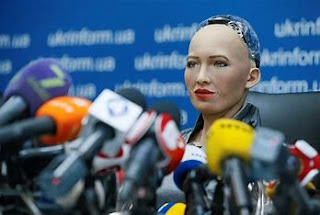ASIMO Robot
- Get link
- X
- Other Apps
ASIMO, short for Advanced Step in Innovative Mobility, stands as a beacon of technological achievement in the field of robotics. Developed by Honda Motor Co., Ltd., ASIMO represents the culmination of decades of research and development in creating humanoid robots capable of advanced mobility and human interaction. Since its debut in the year 2000, ASIMO has captured the imagination of people worldwide and continues to inspire advancements in robotics and artificial intelligence. In this essay, we will delve into the fascinating journey of ASIMO, from its conception to its current state and explore its significance in shaping the future of robotics.
Origins and Development:
The origins of ASIMO can be traced back to Honda's long-standing commitment to innovation and technological excellence. In the late 1980s, Honda engineers embarked on a mission to create a humanoid robot that could walk and interact with humans in real-world environments. Drawing inspiration from the human body's biomechanics, they envisioned a robot capable of emulating human movements with precision and grace.
After years of intensive research and development, Honda unveiled the first prototype of ASIMO in 2000. Standing at 4 feet 3 inches tall and weighing 119 pounds, ASIMO boasted groundbreaking features such as bipedal walking, stair climbing, and autonomous navigation. Its sleek design, coupled with advanced sensors and actuators, showcased Honda's mastery of robotics engineering and paved the way for future advancements in humanoid robotics.
Technological Breakthroughs:
ASIMO's development represented a series of technological breakthroughs that pushed the boundaries of what was possible in robotics. One of its most notable achievements was its bipedal walking capability, which mimicked the natural gait of humans. Through sophisticated algorithms and sensor feedback, ASIMO could adjust its posture and balance in real-time, enabling it to walk on uneven surfaces and navigate complex environments with ease.
Another groundbreaking feature of ASIMO was its ability to interact with humans in a meaningful way. Equipped with advanced voice recognition and natural language processing capabilities, ASIMO could understand and respond to spoken commands, engage in conversations, and even recognize faces and gestures. This human-like interaction set ASIMO apart from previous generations of robots and opened up new possibilities for applications in various fields, including healthcare, education, and entertainment.
Moreover, ASIMO's dexterity and agility were demonstrated through tasks such as opening doors, pouring drinks, and carrying trays, showcasing its potential for assisting humans in everyday tasks. Its ability to adapt to dynamic environments and collaborate with humans in shared spaces heralded a new era of human-robot collaboration, where robots could augment and enhance human capabilities in various domains.
Applications and Impact:
Over the years, ASIMO has been showcased in numerous public demonstrations, exhibitions, and events around the world, captivating audiences with its remarkable capabilities and charm. Beyond its role as a technological marvel, ASIMO has inspired future generations of engineers, scientists, and innovators to push the boundaries of robotics and pursue solutions to some of society's most pressing challenges.
In addition to its public appearances, ASIMO has also been utilized in research and development projects aimed at exploring new applications and capabilities for humanoid robots. From assisting elderly and disabled individuals with daily tasks to performing hazardous duties in disaster zones, ASIMO has demonstrated its potential to improve the quality of life and enhance safety in various scenarios.
Furthermore, ASIMO's impact extends beyond the realm of robotics, serving as a symbol of innovation and ingenuity in the automotive industry. Honda has leveraged its expertise in robotics to develop advanced driver-assist systems and autonomous vehicles, incorporating technologies inspired by ASIMO's sensor fusion and decision-making algorithms.
Challenges and Future Directions:
Despite its remarkable achievements, ASIMO is not without its limitations and challenges. One of the primary obstacles facing humanoid robots like ASIMO is the complexity of human motion and interaction. While ASIMO can perform a wide range of tasks with precision, its movements still lack the fluidity and grace of human motion, limiting its ability to navigate crowded or cluttered environments.
Moreover, the cost and complexity of developing and maintaining humanoid robots pose significant challenges for widespread adoption and commercialization. As such, researchers continue to explore new approaches and technologies to overcome these barriers and unlock the full potential of humanoid robots in real-world applications.
Looking ahead, the future of ASIMO and humanoid robotics holds promise and potential for further advancements. As technology continues to evolve, we can expect to see more sophisticated and capable robots that blur the line between man and machine. From healthcare and hospitality to manufacturing and entertainment, humanoid robots like ASIMO are poised to play an increasingly vital role in shaping the way we live, work, and interact with the world around us.
Conclusion:
ASIMO stands as a testament to the power of human ingenuity and innovation in the field of robotics. From its humble beginnings as a vision of the future to its status as a global icon of technological achievement, ASIMO has captivated the hearts and minds of people around the world. Through its groundbreaking capabilities and pioneering spirit, ASIMO has paved the way for a new era of human-robot collaboration and inspired generations of innovators to push the boundaries of what is possible. As we look to the future, ASIMO serves as a beacon of hope and inspiration, reminding us of the limitless potential of technology to shape a better world for all.
- Get link
- X
- Other Apps



Comments
Post a Comment